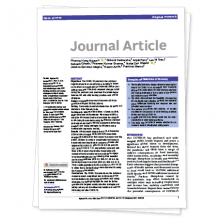Journal article
Apr 01 2017

Social franchising and a nationwide mass media campaign increased the prevalence of adequate complementary feeding in Viet Nam: a cluster-randomized program evaluation (Rawat R., 2017. Journal of Nutrition)
Alive & Thrive (A&T) applied principles of social franchising within the government health system in Viet Nam to improve the quality of interpersonal counseling (IPC) for complementary feeding (CF).
Journal article
Jan 11 2016

Small grants program: Increasing protein and micronutrient content of complementary foods through a caterpillar cereal in the Democratic Republic of Congo
Locally available and sustainable food interventions are needed to combat the problem of malnutrition in infants and young children in low-income countries.
Journal article
Dec 01 2014

Incorporating elements of social franchising in government health services improves the quality of infant and young child feeding counselling services at commune health centres in Viet Nam (Nguyen, P.H., 2014. Health Policy and Planning)
This study assessed the effects of incorporating social franchising on infant and young child feeding (IYCF) counseling facilities and services.
Journal article
Oct 14 2014

Small grants program: Scripted messages delivered by nurses and radio changed beliefs, attitudes, intentions, and behaviors regarding infant and young child feeding in Mexico
This study aimed to evaluate whether an infant and young child feeding (IYCF) nutrition communication strategy using nurses deliverable radio messages changed beliefs, attitudes, social norms, intentions, and behaviors related to breastfeeding (BF), dietary diversity, and food consistency.
Journal article
Oct 01 2014

Program impact pathway analysis of a social franchise model shows potential to improve infant and young child feeding practices in Viet Nam (Nguyen PH., 2014. Journal of Nutrition)
By mapping the mechanisms through which interventions are expected to achieve impact, program impact pathway (PIP) analysis lays out the theoretical causal links between program activities, outcomes, and impacts.
Journal article
May 08 2014

Small grant: Integrating group counseling, cell phone messaging, and participant-generated songs and dramas into a microcredit program increases Nigerian women's adherence to international breastfeeding recommendations
In northern Nigeria, interventions are urgently needed to narrow the large gap between international breastfeeding recommendations and actual breastfeeding practices.

